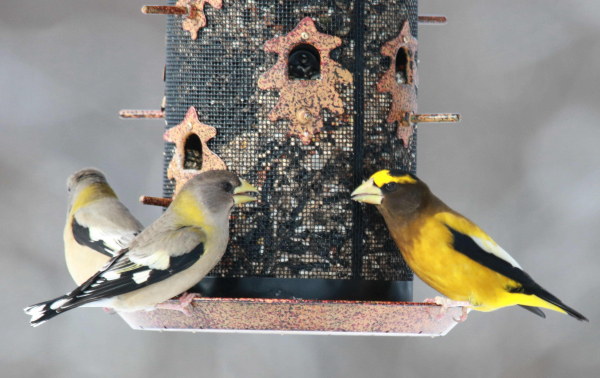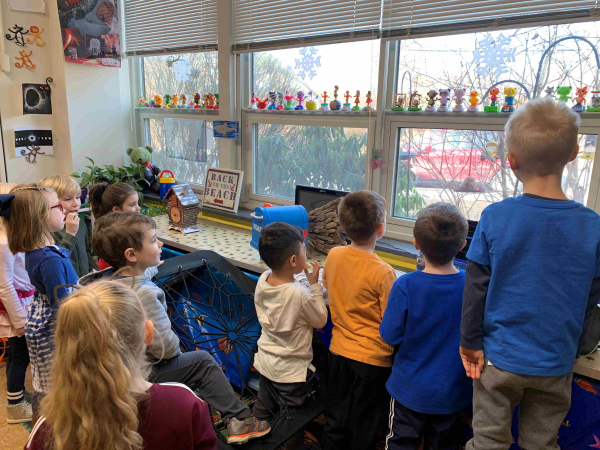
Feeding wild birds at school has proven to be an inspiring activity for students across the continent (Evening Grosbeaks photographed by Paul Konrad).

Elementary students take time to observe birds attracted to their class feeding station. A variety of science activities can be shared by classmates that provide a connection with nature through birds (photo by Elizabeth Mulee).
|
It’s easy to use bird feeding as a lively project at school for all ages of students, bringing nature into view and science into focus. Adding bird feeding and bird study can become a weekly or daily part of a classroom schedule to bring real life action into view. Identifying and counting birds soon becomes second nature and students quickly begin to search for more information about the birds they are seeing – the variety of foods they eat, their migration routes, and their nesting behavior. Birds attract everyone’s attention and pique everyone’s interest – young and old, from pre-school to college.
Feeding birds often leads to students spending more time outside and seeing what birds are in their yards and neighborhoods, and it gives young people a break from the routine (and their computer, cell phone, or tablet screen). Birding is a natural fit with science lessons, but it also promotes cognitive abilities related to discovery and physical activity, while at the same time providing a sense of calm and more alert senses – what’s that I hear? There is no question that feeding and studying birds makes learning more enjoyable and readily ties youths to nature and the outdoors.
Adding a bird bath and a specialized feeder outside a class window can be all students need to become interested – a hummingbird feeder can be a learning magnet. A hopper feeder for black oil sunflower seeds or a tube feeder filled with thistle seeds can bring the most interesting variety of birds into view. What birds will arrive next – cardinals? goldfinches? nuthatches? a woodpecker? A feeding station can encourage students to become more interested in science class or biology lab, but teachers who have added a feeding station have seen a marked increase in interest in all aspects of their coursework when feeder watching activities are added to the curriculum.
Students can also practice a level of responsibility when tasked with adding food to the feeders, cleaning feeders, and filling fresh water in a bird bath. And be sure to provide a field guide to identify the birds, at least one binocular for students to get a closer look, and keep a list of the birds students see to add more value to their bird feeding experiences.
Feeding and observing birds can be a part – and a highlight – of a student’s daily activities, and teachers across the continent have long recognized that bird feeding and the resulting observations are beneficial to their students. Birds also bridge cultural and geographic barriers, offering connections to everyone; plus any student of any age can take part in this activity.
Home schooling parents appreciate the interest generated by birds attracted to foods and water. Some students who are introduced to bird feeding at school become so interested in the activity that they begin their own bird feeding activities at home. This can lead to seeing new species of birds, and sharing that information in class.
Another option for students is to take advantage of the fact that we can find birds almost everywhere, and they can look for bird during a walk through their yard, neighborhood, a nearby park, or they may suggest a family field trip to a nature center or wildlife refuge.
The variety of birds often leads to an interest in all animals, plants, and landscapes. For some people, birding has even piqued their interest to pursue future study in science and natural history.
The fun thing about birds and feeding birds is that you never know what birds might appear, providing a sense of surprise and wonder. It gives students something to look forward to each day in addition to other school activities – it brings new life into view and into our perspectives. Young people clearly enjoy birds at school and at home, and it’s a way for teachers and parents to share and interact in different ways than usual while expanding horizons.
If you are looking for examples of bird feeding used to augment courses in schools, Project FeederWatch has been a source of information as well as inspiration for many teachers. Some have even started after school clubs that provide birding activities for students. You can learn more at You searched for school classroom activities - FeederWatch
Share your backyard birding experiences and photographs with The Birding Wire at editorstbw2@gmail.com